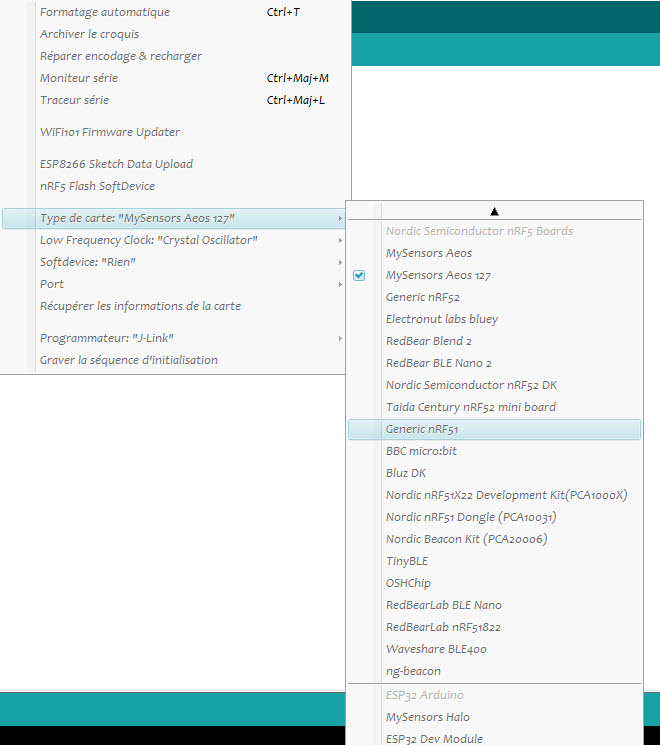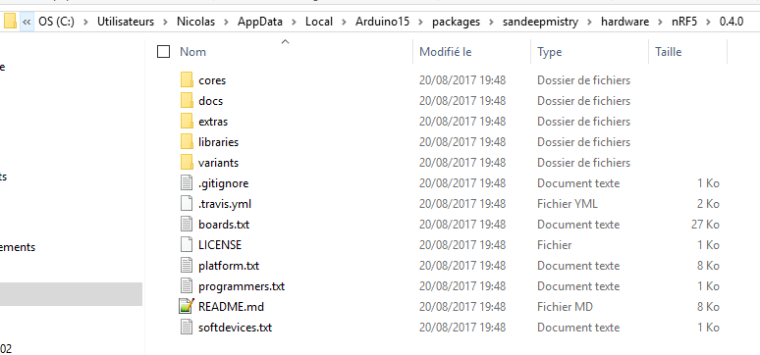💬 MySensors NRF5 Platform
-
@scalz said in 💬 MySensors NRF5 Platform:
@NeverDie
C:\Users...\AppData\Local\Arduino15\packages\MySensors\Thanks!
The good news is that it compiles now. Also, the pin mapping for an LED is working. However, the bad news is that pin mapping for Serial Rx and Tx doesn't seem to be working, so I can't read any serial debug messages. Therefore, not sure if I2C is working or not.
-
I did another purge and reinsatall of the boards, and now serial is working. :)
-
Unfortunately, it does not appear that I2C is working.
-
Curiously, I2c does seem to work on a nRF52 DK using the myboard board definition.
-
However, it doesn't seem to be working on the nrf51.
-
@d00616 You mentioned that it works only with a particular version of GCC. Does that mean I need to have a particular version of the Arduino IDE installed? I'm currently running the latest version of Windows Arduino IDE, which is 1.8.5.
@neverdie said in 💬 MySensors NRF5 Platform:
@d00616 You mentioned that it works only with a particular version of GCC. Does that mean I need to have a particular version of the Arduino IDE installed? I'm currently running the latest version of Windows Arduino IDE, which is 1.8.5.
The GCC version is part of the arduino-nrf5 distribution.
@neverdie said in 💬 MySensors NRF5 Platform:
Unfortunately, it does not appear that I2C is working.
I have I2C and serial running with a NRF52832.
You can try to remove the compat_pin_mapping line and add the 0.1.0 pin map at this place. Then the board definition is nearly the 0.1.0 version.@neverdie said in 💬 MySensors NRF5 Platform:
However, it doesn't seem to be working on the nrf51.
I check the NRF51 board. What do you mean with no working?
-
I hope that narrows down the likely cause of the problem. The fact that it's working on the nRF52 gives me some hope it can be made to work on the nRF51.
-
@neverdie said in 💬 MySensors NRF5 Platform:
@d00616 You mentioned that it works only with a particular version of GCC. Does that mean I need to have a particular version of the Arduino IDE installed? I'm currently running the latest version of Windows Arduino IDE, which is 1.8.5.
The GCC version is part of the arduino-nrf5 distribution.
@neverdie said in 💬 MySensors NRF5 Platform:
Unfortunately, it does not appear that I2C is working.
I have I2C and serial running with a NRF52832.
You can try to remove the compat_pin_mapping line and add the 0.1.0 pin map at this place. Then the board definition is nearly the 0.1.0 version.@neverdie said in 💬 MySensors NRF5 Platform:
However, it doesn't seem to be working on the nrf51.
I check the NRF51 board. What do you mean with no working?
@d00616 said in 💬 MySensors NRF5 Platform:
I check the NRF51 board. What do you mean with no working?
The nRF51 can't find the si7021 device, even though it's connected.
-
@neverdie said in 💬 MySensors NRF5 Platform:
@d00616 You mentioned that it works only with a particular version of GCC. Does that mean I need to have a particular version of the Arduino IDE installed? I'm currently running the latest version of Windows Arduino IDE, which is 1.8.5.
The GCC version is part of the arduino-nrf5 distribution.
@neverdie said in 💬 MySensors NRF5 Platform:
Unfortunately, it does not appear that I2C is working.
I have I2C and serial running with a NRF52832.
You can try to remove the compat_pin_mapping line and add the 0.1.0 pin map at this place. Then the board definition is nearly the 0.1.0 version.@neverdie said in 💬 MySensors NRF5 Platform:
However, it doesn't seem to be working on the nrf51.
I check the NRF51 board. What do you mean with no working?
@d00616 said in 💬 MySensors NRF5 Platform:
I have I2C and serial running with a NRF52832.
Yes, it does seem to work on the nRF52832. Just not presently on the nRF51822.
-
@neverdie said in 💬 MySensors NRF5 Platform:
@d00616 You mentioned that it works only with a particular version of GCC. Does that mean I need to have a particular version of the Arduino IDE installed? I'm currently running the latest version of Windows Arduino IDE, which is 1.8.5.
The GCC version is part of the arduino-nrf5 distribution.
@neverdie said in 💬 MySensors NRF5 Platform:
Unfortunately, it does not appear that I2C is working.
I have I2C and serial running with a NRF52832.
You can try to remove the compat_pin_mapping line and add the 0.1.0 pin map at this place. Then the board definition is nearly the 0.1.0 version.@neverdie said in 💬 MySensors NRF5 Platform:
However, it doesn't seem to be working on the nrf51.
I check the NRF51 board. What do you mean with no working?
@d00616 said in 💬 MySensors NRF5 Platform:
I check the NRF51 board. What do you mean with no working?
I'm running the sparkfun si7021 code. When I run it on the nrf52832, it yields:
Si7021 Found Temp:70.51F, Humidity:40.71%which is correct, but when I run it on the nRF51822, the result is:
No Devices Detected Temp:-51.85F, Humidity:-5.81%which is incorrect.
-
@d00616 said in 💬 MySensors NRF5 Platform:
I have I2C and serial running with a NRF52832.
Yes, it does seem to work on the nRF52832. Just not presently on the nRF51822.
@neverdie said in 💬 MySensors NRF5 Platform:
@d00616 said in 💬 MySensors NRF5 Platform:
I have I2C and serial running with a NRF52832.
Yes, it does seem to work on the nRF52832. Just not presently on the nRF51822.
Can you check, if the device works with the "Generic NRF51822" board? You can edit the variant files in the arduino-nrf5\variants directory.
C:\Users...\AppData\Local\Arduino15\packages\sandeepmistry\hardware\nRF5\0.4.0\variants\Generic -
@neverdie said in 💬 MySensors NRF5 Platform:
@d00616 said in 💬 MySensors NRF5 Platform:
I have I2C and serial running with a NRF52832.
Yes, it does seem to work on the nRF52832. Just not presently on the nRF51822.
Can you check, if the device works with the "Generic NRF51822" board? You can edit the variant files in the arduino-nrf5\variants directory.
C:\Users...\AppData\Local\Arduino15\packages\sandeepmistry\hardware\nRF5\0.4.0\variants\Generic@d00616 said in 💬 MySensors NRF5 Platform:
@neverdie said in 💬 MySensors NRF5 Platform:
@d00616 said in 💬 MySensors NRF5 Platform:
I have I2C and serial running with a NRF52832.
Yes, it does seem to work on the nRF52832. Just not presently on the nRF51822.
Can you check, if the device works with the "Generic NRF51822" board? You can edit the variant files in the arduino-nrf5\variants directory.
C:\Users...\AppData\Local\Arduino15\packages\sandeepmistry\hardware\nRF5\0.4.0\variants\GenericI tried, but I guess I'm not doing it right. I couldn't even get it to blink an LED that way.
-
@neverdie said in 💬 MySensors NRF5 Platform:
@d00616 You mentioned that it works only with a particular version of GCC. Does that mean I need to have a particular version of the Arduino IDE installed? I'm currently running the latest version of Windows Arduino IDE, which is 1.8.5.
The GCC version is part of the arduino-nrf5 distribution.
@neverdie said in 💬 MySensors NRF5 Platform:
Unfortunately, it does not appear that I2C is working.
I have I2C and serial running with a NRF52832.
You can try to remove the compat_pin_mapping line and add the 0.1.0 pin map at this place. Then the board definition is nearly the 0.1.0 version.@neverdie said in 💬 MySensors NRF5 Platform:
However, it doesn't seem to be working on the nrf51.
I check the NRF51 board. What do you mean with no working?
@d00616 said in 💬 MySensors NRF5 Platform:
You can try to remove the compat_pin_mapping line and add the 0.1.0 pin map at this place. Then the board definition is nearly the 0.1.0 version.
So, I take it you are suggesting that in myboardnrf5.cpp, where it says:
#ifdef MYBOARDNRF5 #include <variant.h> #include <compat_pin_mapping.h>I replace
#include <compat_pin_mapping.h>with what exactly? At this point I'm not even sure where 0.1.0 pin-map is, or even what it's called.
-
@d00616 said in 💬 MySensors NRF5 Platform:
@neverdie said in 💬 MySensors NRF5 Platform:
@d00616 said in 💬 MySensors NRF5 Platform:
I have I2C and serial running with a NRF52832.
Yes, it does seem to work on the nRF52832. Just not presently on the nRF51822.
Can you check, if the device works with the "Generic NRF51822" board? You can edit the variant files in the arduino-nrf5\variants directory.
C:\Users...\AppData\Local\Arduino15\packages\sandeepmistry\hardware\nRF5\0.4.0\variants\GenericI tried, but I guess I'm not doing it right. I couldn't even get it to blink an LED that way.
@neverdie said in 💬 MySensors NRF5 Platform:
I tried, but I guess I'm not doing it right. I couldn't even get it to blink an LED that way.
After I modify the generic variant board definition, is there some trick to making it go "live"?
-
I think this must be where the disconnect is happening. Where do I find the files or directory for Generic nRF51? The closest I see is a directory called just "Generic":
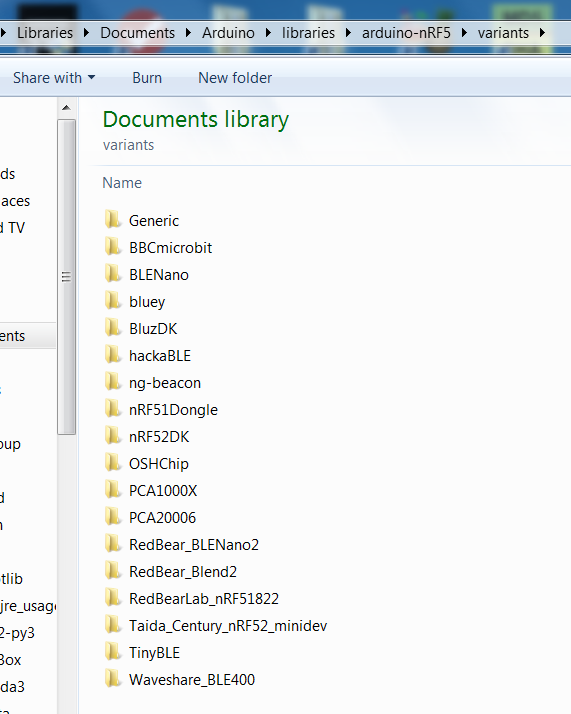
That's the one I tried modifying:
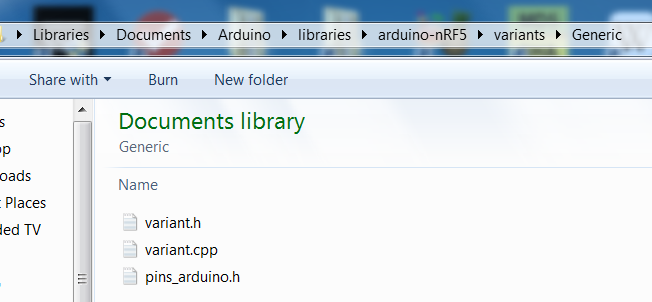
and it had no effect. So, I suspect there must be a different "generic nRF51" somewhere which is closely tied with the menu item you show the picture of. However, I don't see where. -
I think this must be where the disconnect is happening. Where do I find the files or directory for Generic nRF51? The closest I see is a directory called just "Generic":

That's the one I tried modifying:

and it had no effect. So, I suspect there must be a different "generic nRF51" somewhere which is closely tied with the menu item you show the picture of. However, I don't see where. -
I didn't try that one, but it's a similar dilemma:
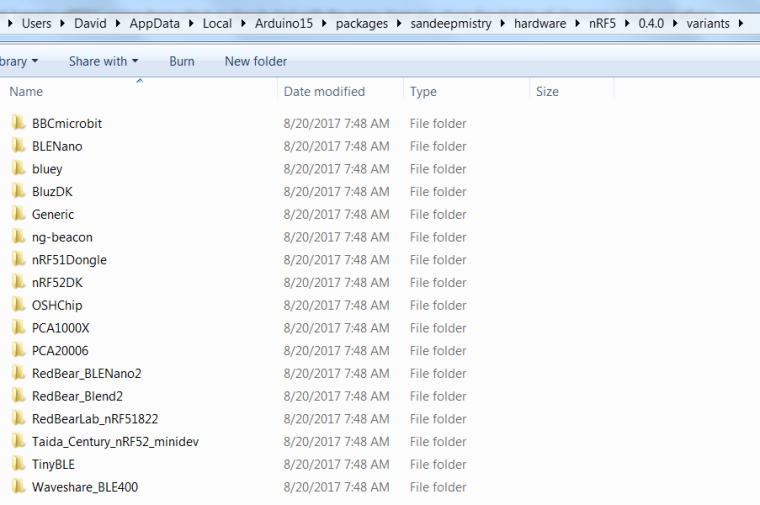
i.e. Does "Generic" do double duty for both "Generic nRF51" and "Generic nRF52"? -
Aha! That did it. Thanks @NCA78. It's working now, including the I2C.
I had to switch nodes though. It's possible that the mysensors code does work, as the node I was testing it on may have had a bad si7021 module on it. I'll post again after I retry with this different node.

